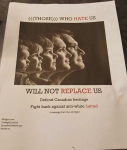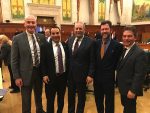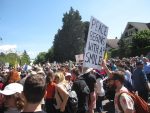Israel’s Ministry of the Diaspora recently announced what it calls the most advanced system of its kind in the world to track antisemitic content on social media.
The Anti-Semitism Cyber Monitoring System, or ACMS, can find relevant posts that are antisemitic (using the definition devised by the International Holocaust Remembrance Alliance) on Facebook and Twitter in English, French, German, Arabic. It can see who posted and shared the comments. Other languages and social media platforms are expected to be added to the system as it progresses.
In a month-long trial run, the system identified 409,000 antisemitic posts by 30,000 individuals. Whether the system can or cannot catch every instance of antisemitism online is less significant than the fact that it is a tool to identify trends. In the trial, the system identified the world’s “most antisemitic cities” as Santiago, Chile; Dnipro, Ukraine; and Bucharest, Romania. Western cities that topped the online antisemitism list were Paris and London.
This is relevant research. It would be useful to know where Vancouver or Canada falls in such a ranking. That kind of information could help our community work with governments and other agencies to address the topic and devote resources to education and countering hatred.
But information is power. And power can corrupt. There is a difference between accumulating information that is (or can be) anonymized to allow for research into the topic. It is also fair to use such a system to identify individuals who should be reported to authorities for investigation for potential contravention of hate laws or for exhibiting potential for violence. But the words from Israel’s Diaspora Affairs Ministry Naftali Bennett were not reassuring. According to the Times of Israel, Bennett said the system would expose online antisemites “for all to see.”
“The time has come to put a mirror in front of our haters and expose the ugly face of modern antisemitism,” Bennett went on. “From now on, we’ll know who every antisemitic inciter is.”
Anyone who has spent time online and confronted the sorts of nastiness that exists there might find a sort of satisfaction at the idea that some of the people who are purveying the worst Jew-hatred will no longer get off scot-free. But let’s take a step back.
It is one thing for an intelligence agency – or a responsible nongovernmental organization such as the Southern Poverty Law Centre – to accumulate information like this for the purposes of research, monitoring dangers and notifying appropriate authorities. It would be quite another if, as Bennett seems to suggest, a government (or other agency) were to make public an online database of people who express offensive or racist comments online.
There is a website called Canary Mission, which, according to its self-definition, “documents people and groups that promote hatred of the USA, Israel and Jews on North American college campuses.”
The site is a compendium of individuals who have made comments online or been seen at events of various types and includes links to their LinkedIn, Facebook, Twitter and other social media pages.
Some of the comments Canary Mission has assembled are indeed disturbing. “I swear if [a] Jew gets within 5 feet from me at the protest and says a word, straight murder,” one person wrote. “Ima kill a jew in a month,” wrote another.
There is also no doubt that, among these people, most of whom are university students, are some who have been drawn into anti-Israel movements and have made, as many of us do, occasional untoward comments on social media. It may be fine to call these comments out, but it is not acceptable to assemble in one place a group of people who vary widely – from those who should be reported to authorities for posing a danger to society to some who are probably legitimately attempting to make a peaceful political statement, however misguided we may think that message is.
This approach encourages vigilantism. It is the sort of tactic that has been used in the past by anti-abortion terrorists who have murdered or attempted to murder healthcare providers, including one right here in Vancouver who was shot through a window in his home.
Consider – and there is absolutely no reason to view this as far-fetched – that a website was set up to aggregate information about you, your parents, your children and anyone else you know who has traveled to Israel, donated to Zionist causes or attended pro-Israel events. There are a lot of irrational people in the world and a project like this could help them act out in potentially catastrophic ways.
Again, there is value and importance in accumulating this information. It should be shared with relevant authorities, including the universities, police, FBI, CSIS and so forth. But we should not be encouraging the public dissemination of this material. It is an extremely hazardous game.





